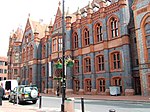Reading Central (UK Parliament constituency)
Constituencies of the Parliament of the United Kingdom established in 2024EngvarB from October 2013Parliamentary constituencies in BerkshirePolitics of Reading, Berkshire

Reading Central is a constituency in the House of Commons of the UK Parliament. It was formed as a result of the 2023 Periodic Review of Westminster constituencies. It subsumes parts of the former Reading West and Reading East constituencies but, unlike them, the whole of the new constituency will be within the Borough of Reading. It will be first contested in the 2024 general election.
Excerpt from the Wikipedia article Reading Central (UK Parliament constituency) (License: CC BY-SA 3.0, Authors, Images).Reading Central (UK Parliament constituency)
Vastern Road,
Geographical coordinates (GPS) Address Website Nearby Places Show on map
Geographical coordinates (GPS)
| Latitude | Longitude |
|---|---|
| N 51.46 ° | E -0.97 ° |
Address
Reading Railway Station Car Park
Vastern Road
RG1 8DB , Caversham
England, United Kingdom
Open on Google Maps









